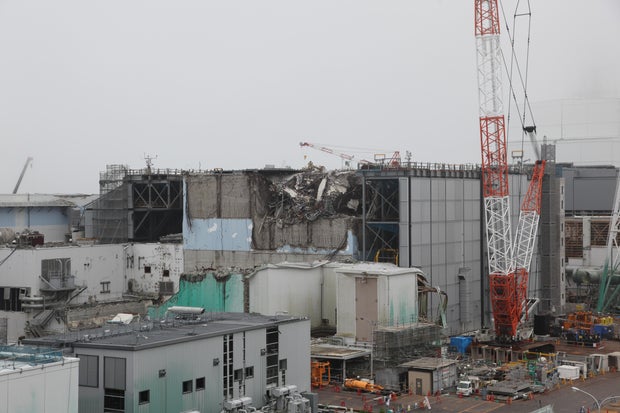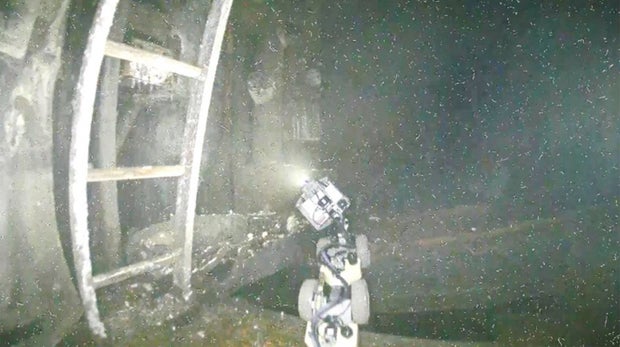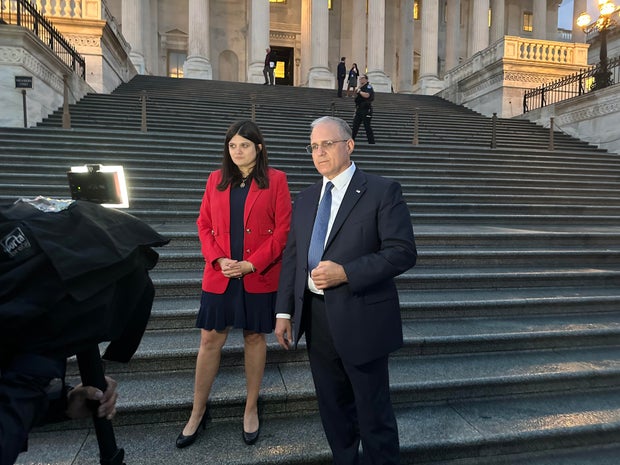CBS News
Challenging next phase of Fukushima nuclear plant cleanup begins with robot set to gather nuclear fuel debris

Tokyo – An extendable robot began a two-week mission Tuesday to retrieve the first sample of melted fuel debris from inside one of three damaged reactors at the Fukushima Daiichi nuclear power plant. Highly radioactive fuel and other materials in the reactors melted when a massive earthquake and tsunami in 2011 damaged the plant’s cooling systems.
The plant’s operator, Tokyo Electric Power Company Holdings, has previously used small robots to examine the inside of the reactors, but Tuesday was to be the first attempt by the robot and its operators to collect a sample of the melted debris. The operation marks the beginning of the most challenging part of the plant’s decades-long decommissioning.
The mission was initially scheduled to begin on Aug. 22 but was suspended when workers noticed that the 5-foot pipes they were using to push the robot into the reactor had been arranged in the wrong order, TEPCO said. The equipment was reassembled in the right order for Tuesday’s attempt, the company said.
Once inside the reactor vessel, the robot, nicknamed “telesco,” is operated remotely from a safer location.
The robot can extend to a length of about 72 feet, including the pipes pushing it from behind, to reach the melted fuel mound, where it will use tongs to collect a fragment measuring less than a tenth of one ounce. It is expected to take about two weeks to obtain the fragment.
An estimated 880 tons of fatally radioactive molten fuel remains inside the three crippled reactors.
Chief Japanese government spokesperson Yoshimasa Hayashi noted that the mission marked the start of the most difficult phase of the Fukushima Daiichi cleanup.
“The government will firmly and responsibly tackle the decommissioning until the very end,” he vowed.
Pallava Bagla/Corbis/Getty
The government and TEPCO have set a 30- to 40-year target for the cleanup, despite criticism that the timescale is unrealistic. No specific plans for the full removal of the melted fuel debris or its storage have been decided.
In March, TEPCO released a dozen images taken by the miniature drones sent deep into a badly damaged reactor at the plant, showing displaced control equipment and misshapen materials, but leaving many questions unanswered about the daunting task of decommissioning the facility. The photos were the first from inside the main structural support called the pedestal in the hardest-hit No. 1 reactor’s primary containment vessel, an area directly under the reactor’s core.
The high-definition color images captured by the drones showed brown objects with various shapes and sizes dangling from various locations in the pedestal. Parts of the control-rod drive mechanism, which controled the nuclear chain reaction inside the reactor, and other equipment attached to the core, were dislodged.
TEPCO via AP
TEPCO officials said they were unable to tell from the images whether the dangling lumps were melted fuel or melted equipment without obtaining other data, such as radiation levels. The drones didn’t carry dosimeters to measure radiation as they had to be lightweight and maneuverable.
The drone cameras could not see the bottom of the reactor core, in part because of the darkness of the containment vessel, officials said.
Officials hope the information from those initial probes and the looming sample mission using the larger robot will help them to develop technologies and other robots to complete the removal of the highly radioactive waste.
CBS News
JD Vance echoes Trump, blames Democrats for apparent assassination attempt

Watch CBS News
Be the first to know
Get browser notifications for breaking news, live events, and exclusive reporting.
CBS News
9/17: The Daily Report with John Dickerson

Watch CBS News
Be the first to know
Get browser notifications for breaking news, live events, and exclusive reporting.
CBS News
Paul Whelan, freed in prisoner swap with Russia, tells other American detainees: “We’re coming for you”

Washington — Nearly seven weeks after the Russians handed over Paul Whelan on a tarmac in Ankara, Turkey, the Marine veteran stood on the steps of the U.S. Capitol with a message for other Americans who are held abroad.
“We’re coming for you,” he told reporters Tuesday night after he met with lawmakers. “It might take time, but we’re coming.”
Whelan said he spoke with lawmakers about how the government can better support detainees after they’re released.
“We spoke about how the next person’s experience could be better,” he said. “What the government could do for the next person that’s held hostage and comes home — the care and support that other people might need, especially people that are in a worse situation. There are people coming back that lived in the dirt without shoes for three years, people that were locked up in hideous conditions for 20 years. They need support.”
CBS News
The U.S. secured Whelan’s release in August in one of the largest prisoner swaps since the end of the Cold War. The complex deal came after months of sensitive negotiations between the U.S., Russia, Germany, Slovenia, Poland and Norway.
As part of the deal, Russia released 16 prisoners while the Western countries released eight Russians. Whelan was released alongside Wall Street Journal reporter Evan Gershkovich, Russian-American radio journalist Alsu Kurmasheva and Vladimir Kara-Murza, a U.S. green card holder and Kremlin critic.
Whelan, who had been the longest-held American detainee in Russia, was arrested in December 2018 when he traveled to the country to attend a friend’s wedding. He was convicted of espionage in a secret trial and sentenced to 16 years in prison in 2020.
Whelan, his family and the U.S. government vehemently denied that he was a spy and accused Russia of using him as a political pawn. The U.S. government considered him to be wrongfully detained, a rare designation that put more government resources toward securing his release.
But a deal to secure his freedom was long elusive. He remained behind bars as Russia freed Marine veteran Trevor Reed and women’s basketball star Brittney Griner — both of whom were detained after Whelan’s arrest — in prisoner swaps with the U.S.
The U.S. said it pushed for his inclusion in both exchanges, but Russia refused. It led to Whelan advocating for his own release from a remote prison camp, calling government officials and journalists to make sure that he wasn’t forgotten.
When the plane carrying Whelan, Gershkovish and Kurmasheva landed in Maryland on Aug. 1, Whelan was the first to disembark. He was greeted by President Biden, who gave Whelan his American flag pin, and Vice President Kamala Harris.
“Whether he likes it or not, he changed the world,” Rep. Haley Stevens, a Michigan Democrat, told reporters Tuesday.
Whelan’s case and his family’s constant pressure on the U.S. government brought more attention to the cases of Americans who are wrongfully detained by foreign governments.
Haley said Whelan is a reminder to other Americans considering traveling to Russia that “you have a target on your back.”
Whelan said it’s been an adjustment acclimating to life back in the U.S., especially learning the latest technology like his iPhone 15.
“I was in a really remote part of Russia,” he said. “We really didn’t have much. The conditions were poor. The Russians said the poor conditions were part of the punishment. And coming back to see this sort of thing now is a bit of a shock, but it’s a good shock.”











